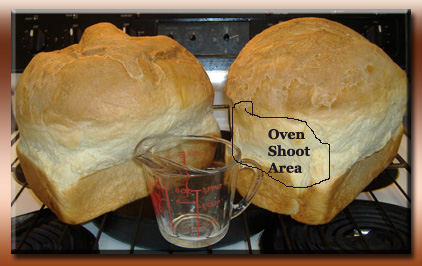How do you guys get an overspring? I can never get one, not even a 1cm spring. For my last batch of bread I preheated the oven to 500F for 15-20mins, put the dough (covered with alumminum foil) and brushed water on the top of the bread to keep the to soft then turned the temp to 350F but still no ovenspring. I did forget to score the dough but I didn't want to do it since I was making "dinner rolls", wanted something smooth.
Something like this would be awesome.

Btw, is there a way to brush water to the underside (bottom) of the dough? I like to brush water to the top during the second rise so it would end up soft instead of cracky/crunchy/hard.
Hi Wek, you don't say much about your technique, so my answer tries to cover multiple places where you could be going wrong. This is targeted at bread in general, not just rolls. The top advice is to slightly underproof -- see item 5.
The main things that helped me get ovenspring are:
1. Don't work too much flour into the dough. Weigh, don't measure the flour. And if you do measure, spoon it into the cup then level; don't jam the cup into the flour bag. Aim for a tacky to slightly sticky dough, not a dry one (depending on the recipe of course, but when I started baking my main error was thinking dough should be comfortably dry to work with, and quite stiff and firm).
2. Make sure your yeast, regardless of type, is fresh enough.
3. For the 1st rise and proofing, go by the amount of rise, not the clock.
4. Preheat longer, 45 min. to an hour. You lose a lot of heat when you open the door, and 15 min. of preheating will get the air in the oven hot, but won't really get the body hot enough to recover quickly after you open the door. Consider preheating to maximum then turning the oven down after loading the bread. Consider baking in a fully preheated Dutch Oven, also. If you do this, e.g. for a boule, you'll proof the loaf on a sheet of baking paper with extra length on the sides which you'll use to lower the loaf into the hot DO after pulling it out of the oven temporarily. The DO is a heat sink, gets you a better bottom crust (if you want one), and with the lid on, traps the loaf's own steam in for the first 3/4 of the baking time, which helps it rise. You'll crack the lid open or remove it for the last bit, to help the top crust form.
5. Most importantly, for the proofing, put it in the oven when it's risen about 70% (experiment with 50%-80%, certainly NOT doubled). That way the yeast still has food and energy to work with during the oven spring period. Just this one change may be enough for your rolls -- give it a try!
6. They say that shaping properly, with good surface tension on a roll or loaf, helps.
7.Put a heavy cast iron or steel pan in the bottom of the oven before preheating. When you load the bread, open the oven door for as little time as possible. Close it. Grab a half cup of boiling water and toss it on that hot pan and close the door quickly. This will produce steam to help keep the bread surface from drying, and the steam also transmits heat to the loaf.
What recipe are you using? That can help diagnose your oven spring question.
I usually get the best spring when:
1. I bake dough in a cast iron pot, covered (a.k.a.copious initial steam!)
2. the dough is fully fermented, but not over-fermented.
3. the gluten in the dough is reasonably well-developed (not too much!)
Oven spring is the "last hurrah" for your yeast and the gas inside the bread, so you want to optimize both of these conditions.
Try using a bit more yeast in your recipe, as well as steam. Also make sure your final dough (after shaping) has almost (but not quite) doubled.
See if that helps.
...and what Dragonbones said... :)
Holy crap, those are some "interesting" looking loaves, looks like they were made in a casserole dish. Nice and springy though.
For soft crust, don't use water. Water will only make the crust crispy or crunchy. Use soft butter underneath and top side.